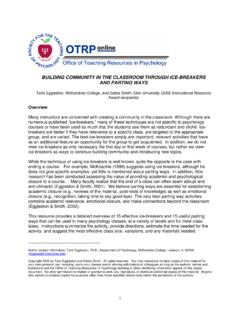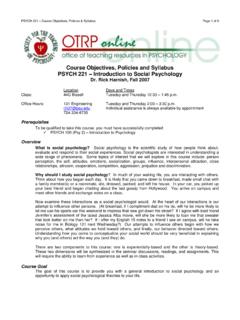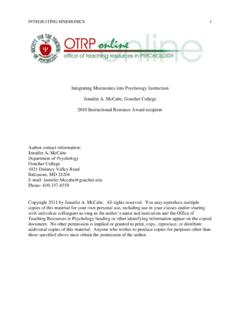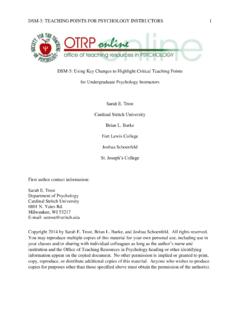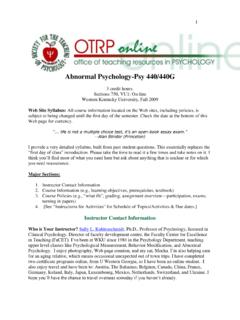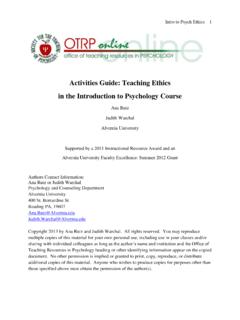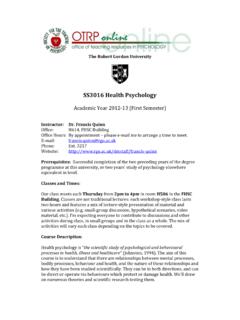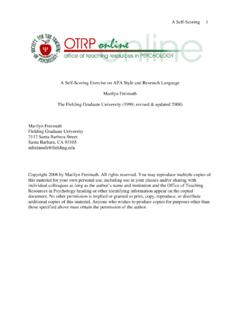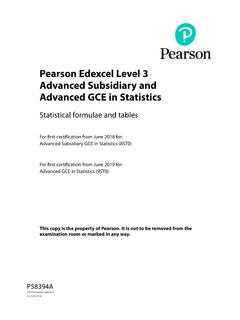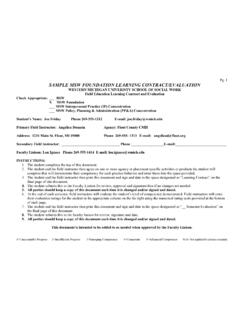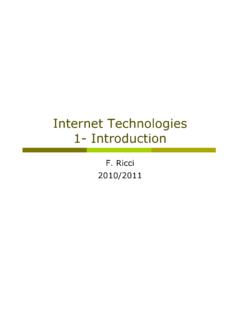Transcription of Learning and Memory Strategy Demonstrations for the ...
1 Learning & Memory 1 Learning and Memory Strategy Demonstrations for the Psychology Classroom Jennifer A. McCabe Goucher College 2013 Instructional Resource Award recipient Author contact information: Jennifer A. McCabe Department of Psychology Goucher College 1021 Dulaney Valley Road Baltimore, MD 21204 E-mail: Phone: 410-337-6558 Copyright 2014 by Jennifer A. McCabe. All rights reserved. You may reproduce multiple copies of this material for your own personal use, including use in your classes and/or sharing with individual colleagues as long as the author s name and institution and the Office of Teaching Resources in Psychology heading or other identifying information appear on the copied document. No other permission is implied or granted to print, copy, reproduce, or distribute additional copies of this material.
2 Anyone who wishes to produce copies for purposes other than those specified above must obtain the permission of the author. Learning & Memory 2 Overview This 38-page document contains an introduction to the resource, background information on Learning and Memory strategies, a summary of research on undergraduate student metacognition with regard to these strategies, and a collection of classroom Demonstrations that allows students to experience real-time the effectiveness of specific Learning and Memory strategies. References are included at the end of the document. Table of Contents Page I. Introduction 3 II. Background Information on Strategies and Metacognition 4 III. Classroom Demonstrations of Learning and Memory Strategies 5 A. Deep Processing 6 B. Self-Reference Effect C. Spacing Effect 10 12 D. Testing Effect 16 E.
3 Imagery F. Chunking 17 22 G. Mnemonics 25 H. Generation Effect 30 IV. References 34 V. Acknowledgements 38 Learning & Memory 3 I. Introduction The purpose of this resource is to provide psychology instructors with an annotated collection of in-class Learning and Memory Strategy Demonstrations . The Demonstrations illustrate strategies that are empirically validated as effective for long-term Memory retention and are readily applicable to both the psychology classroom and, more broadly, to college students study skills. Teaching students about effective Learning and Memory strategies is a first step toward improving metacognitive sophistication ( , Learning how to learn); an important next step is to find ways to encourage students to actually change their behaviors and implement these strategies in their daily lives, most notably in the context of Learning information for college courses.
4 One way psychology instructors can improve student exposure to, confidence in, and motivation to implement the recommended Learning strategies is to incorporate in-class Demonstrations of each Strategy s effectiveness. This technique allows students to witness in real-time the Memory advantage of certain strategies ( , imagery) over others ( , verbal repetition). The Demonstrations included in this resource represent an effort to translate research from cognitive psychology into the arena of higher education. This translational piece has been a focus of recent publications from renowned researchers in the field ( , Dunlosky, Rawson, Marsh, Nathan, & Willingham, 2013; Roediger & Pyc, 2012). As such, researchers in psychological science now ask (and ideally answer) questions regarding what their basic research findings imply for real-world educational practice.
5 This resource will help teachers explore one way to translate research findings into the everyday experience of college students. This project is relevant to teachers of psychology on multiple levels. First, teachers who include a section on human Memory in their courses ( , Introduction to Psychology, Cognitive Psychology, Learning and Memory ) may benefit from a teaching resource that includes evidence for beneficial Learning and Memory strategies. At a basic level, incorporating this information and these Demonstrations into such classes should improve students knowledge about how Memory works. Second, this resource may be particularly valuable to those who teach first-year and/or underprepared students, as these students may especially need training in the metacognitive aspects of Learning how to learn. At an applied level, these Demonstrations illustrate in real-time the Memory benefits of specific strategies, and then class discussion and follow-up assignments could encourage students to implement such strategies in their college courses and also in Memory tasks in their everyday lives.
6 For advanced courses in particular, the Demonstrations can provide an effective scaffold for discussions of Memory theories. As teachers of psychology, we have a responsibility to share the research findings in our discipline with students to help them acquire the skills for lifelong Learning . It is one thing to tell students about the best way to learn, but quite another to show them that some strategies are more successful than others. This aha moment in class when, for example, students realize that all it took was a bit of mental imagery to improve Memory far beyond verbal repetition, is rewarding for students and educators alike. This resource provides teachers with the materials to help their students engage in interesting exercises aimed at helping them become more strategic and successful learners. Learning & Memory 4 II.
7 Background Information on Strategies and Metacognition A large body of literature now exists to document, at least in the laboratory, the Memory benefits of Learning strategies such as deep (elaborative) processing ( , Craik & Lockhart, 1972), the self-reference ( , self-referential processing) effect ( , Rogers, Kuiper, & Kirker, 1977), spaced study (or distributed practice; , Rohrer & Pashler, 2007), retrieval practice (the testing effect; Roediger & Karpicke, 2006), imagery (dual-coding; Paivio, 1986), chunking ( , Butterworth, Shallice, & Watson, 1990), mnemonics ( , Bellezza, 1996; for a review, see McCabe, 2011a), and learner-created study materials (the generation effect; , Slamecka & Graf, 1978). See Roediger and Pyc (2012) for a review of several of these strategies. Although research has established the strategies listed above as beneficial for Memory , compelling evidence suggests that many college students have low metacognitive awareness, so these strategies could be helpful for their Learning (Kornell & Bjork, 2007; McCabe, 2011b).
8 This lack of awareness may be particularly relevant to those strategies that Bjork (1994) termed desirable difficulties, the types of activities that make Learning slower and more error-prone in the short term, but have longer-term Memory benefits. Research shows that college students sometimes believe that the opposite of effective strategies are best for Memory ( , re-reading versus retrieval practice, or testing; , McCabe, 2011b; Roediger & Karpicke, 2006). In addition, many strategies self-reported by undergraduates are non-elaborative and unsupported by research ( , re-reading, highlighting; Hartlep & Forsyth, 2000; Karpicke, Butler, & Roediger, 2009). As learners may not have metacognitive sophistication to judge the most effective Learning methods on their own, it is critical that instructors assist them in acquiring these beneficial techniques.
9 Basic research suggests that learners are more likely to use a Strategy that they have experienced as beneficial for their own Memory ( , Bjork, deWinstanley, & Storm, 2007; Murphy, Schmitt, Caruso, & Sanders, 1987). Thus, demonstrating the most effective strategies in class could help improve strategic choices and minimize the metacognitive disconnect noted above. Specific to mnemonic techniques, Carney, Levin, and Levin (1994) recommended that instructors provide in-class mnemonstrations, with the goal that students would then take more ownership of mnemonic creation and use over time. Based on empirical research conducted in his introductory psychology class, Balch (2005) suggested that instructors teach students about elaborative methods such as keyword mnemonics and real-life examples by including these in lecture materials.
10 In a more holistic approach to Memory Strategy instruction, Shimamura (1984) developed an entire short course focusing on Memory skills, emphasizing that instructors must take the time to provide training and practice to bolster successful Strategy use. My own research has shown that explicit in-class instruction about effective Learning techniques is associated with improved knowledge of these desirably difficult strategies (McCabe, 2011b). Others have demonstrated that instruction on applied Learning and Memory topics is associated with increased metacognition and subsequent academic performance ( , Azevedo & Cromley, 2004; Fleming, 2002; Tuckman, 2003). Assuming that instructors want students to change their strategic study behaviors, one way to make progress toward this goal is to integrate Learning and Memory Strategy Demonstrations into the psychology classroom.
